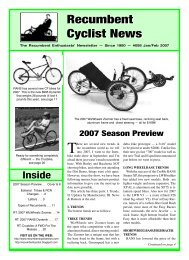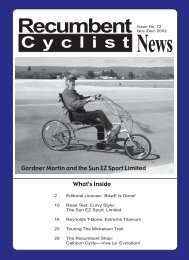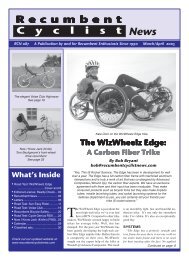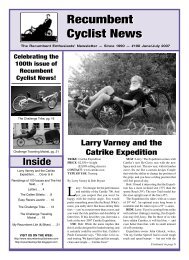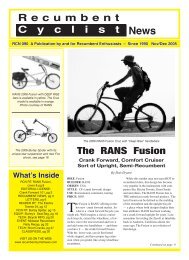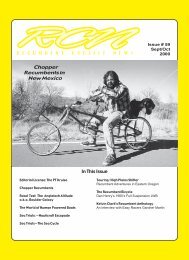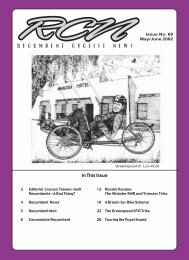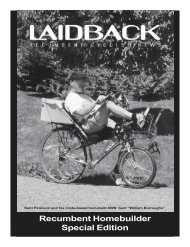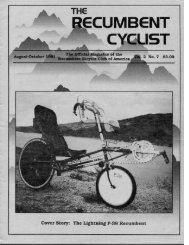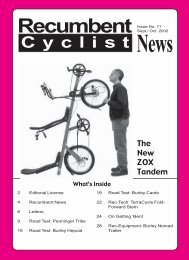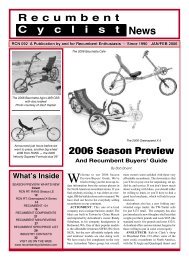C y c l i s t Recumbent - Steve Briggs
C y c l i s t Recumbent - Steve Briggs
C y c l i s t Recumbent - Steve Briggs
You also want an ePaper? Increase the reach of your titles
YUMPU automatically turns print PDFs into web optimized ePapers that Google loves.
<strong>Recumbent</strong><br />
C y c l i s t News<br />
“A newsletter by and for recumbent bicycle<br />
enthusiasts, since 1990.”<br />
Subscription Information<br />
<strong>Recumbent</strong> Cyclist News is published six times<br />
per year, every other month. See below for subscription<br />
rates.<br />
Contact<br />
RCN, PO Box 2048, Port Townsend, WA 98368<br />
Tel. 360-379-5607<br />
E-mail: bob@recumbentcyclistnews.com<br />
Web: www.recumbentcyclistnews.com<br />
Mailing Info<br />
Mailing Label: “EXPIRES 084” means that RCN<br />
084 is the last issue of your current subscription.<br />
Address Changes: Please allow 6-8 weeks<br />
notice for address changes. Standard mail: RCN<br />
is mailed USPS 3rd class — which is NOT<br />
forwardable. If you move often, have multiple<br />
addresses or file address forwarding requests<br />
with the USPS, please use our first class mail<br />
subscription option.<br />
Fine Print<br />
© 2004 by Planet PT, Inc. in Port Townsend, WA.<br />
Contents may not be reproduced in whole or<br />
part unless expressly authorized in writing. ◆<br />
Subscribe To <strong>Recumbent</strong><br />
Cyclist News Today!<br />
• Read all about it!<br />
• Road Tests<br />
• News & Rumors<br />
• Critical Analysis<br />
• Adventure Stories<br />
• Technical articles<br />
RCN is published SIX times per year,<br />
every other month<br />
❑ $30 One Year USA/6-issue 3rd class mail<br />
❑ $40 One Year USA First Class Mail in env.<br />
❑ $56 Two Year USA/12-issue 3rd class mail<br />
❑ $42 Canadian Airmail (USA Funds only)<br />
❑ $60 Worldwide Airmail in envelope<br />
❑ $34 Six back issues (USA)<br />
❑ $6 One back issue or 2004 Buyers’ Guide<br />
(See web or classifieds for issue list) (USA)<br />
Name:__________________________<br />
Address:________________________<br />
City:___________________________<br />
State/Zip:_______________________<br />
Email/Tel:_______________________<br />
Mail To:<br />
RCN, PO Box 2048<br />
Port Townsend, WA 98368<br />
For faster service, visit our website and<br />
order via PayPal:<br />
www.recumbentcyclistnews.com<br />
2 <strong>Recumbent</strong> Cyclist News<br />
Editorial License:<br />
Weight, Performance & Comfort<br />
by Bob Bryant, Publisher<br />
bob@recumbentcyclistnews.com<br />
Weight is a serious issue with bicycle<br />
buyers — upright or recumbent.<br />
Gram counting has become an ongoing<br />
obsession amongst lycra-clad recumbent<br />
roadies. Everybody wants to know:<br />
• Does weight matter?<br />
• How does it matter?<br />
• How much is too heavy?<br />
The fact is that bike and wheel weight does<br />
matter — most all recumbents are heavy by<br />
modern road bike standards.<br />
Like many of you, I spent much of July<br />
watching the Tour de France. In fact, I became<br />
consumed by it. I also watched the Lance<br />
Chronicles which showcases Lance<br />
Armstrong, the US Postal team and his Trek<br />
bikes. On one particular segment a behind the<br />
scenes view of the Trek factory and some of<br />
the new carbon-fiber road bike technology.<br />
Trek can produce a road bike that weighs just<br />
14 pounds! The minimum racing weight for a<br />
Tour de France bike is 14.991 pounds.<br />
One thing is for certain, it will be difficult<br />
for the recumbent world to take advantage of<br />
this Trek-like bicycle technology. As an industry,<br />
we do we need to get out from behind<br />
the eight ball and catch up if we’re going to<br />
compete. <strong>Recumbent</strong>s need to go on a diet.<br />
Rider Weight & Fitness<br />
Before we spend thousands of dollars buying<br />
lighter models, upgrading to lighter components<br />
or performance enhancing products,<br />
we also need to consider our body weight and<br />
fitness levels. Since we’re talking about human-powered<br />
bicycles, and not motor vehicles,<br />
the condition of our own motors and bodies<br />
plays an important part in the equation.<br />
Those who spend big bucks on fast<br />
recumbents should really be training thousands<br />
of miles per year, and be as fit as they can be.<br />
Losing bad habits like smoking, drinking and<br />
fast food helps as well. Sorry if this sounds<br />
preachy, I’m not perfect either. For me, this is<br />
a lifelong quest.<br />
Comfort & Performance<br />
Some recumbent riders may be trading off<br />
comfort for performance. Some of the current<br />
go-fast bikes have reclined seats (possibility<br />
of neck discomfort), stiff frames (stiff ride) and<br />
high foot positions (possibility of numb feet<br />
and/or toes). Most will agree that the hard-shell<br />
seats perform better than mesh; however, are<br />
they as comfortable? You will need to decide<br />
whether or not these trade-offs bother you, and<br />
if they do — are they worthwhile?<br />
My primary motivation for riding a recumbent<br />
is COMFORT. If performance comes, it<br />
is an additional benefit. Sadly, there are far too<br />
many heavy and sluggish recumbents being<br />
sold today. If you want a fast recumbent, look<br />
for a known performance oriented recumbent<br />
and then see if it’s comfortable for you. These<br />
will most likely be one of the following:<br />
highracer, lowracer, faired SWB OSS, or<br />
faired LWB OSS (in no particular order). Fast<br />
trikes exist, but I’ve always been faster on two<br />
wheelers.<br />
Hills & Weight<br />
An interesting fact about going downhill is<br />
that a heavier bike will go faster (if all else is<br />
equal). On flats it probably doesn’t matter as<br />
much, especially if you’ve spent some of your<br />
precious grams on a fairing and some performance<br />
tires. Where weight can “get you” is<br />
climbing. Those who charge and attack hills<br />
on recumbents like their roadie counterparts<br />
are a rare breed and usually riding highracers<br />
or lowracers. Most recumbent riders tend to<br />
gear down and spin up hills at a slow to moderate<br />
pace.<br />
Some riders are not concerned about weight<br />
at all, but are still fast. One such rider I know<br />
has an Easy Racer TiRush. While not a heavy<br />
bike, his is loaded with goodies: rack, fenders,<br />
double leg kick stand, body sock, and fairing.<br />
I asked him how much it weighed, and he<br />
gave me an all-knowing “why would I care”<br />
look and a shrug of the shoulders. Few in this<br />
county can keep up with him.<br />
Performance Devices<br />
With recumbents, we need to ask ourselves<br />
whether certain performance aiding devices are<br />
worth the added weight. These items could be:<br />
• Wider range gearing<br />
• Components (like the Rotor crank)<br />
• Fairings/body stockings<br />
• Tail boxes<br />
All of these items may be worth their weight<br />
for flat land or downhill riding, but they absolutely<br />
add weight which can slow you down<br />
in climbs. Some may argue that your flat land<br />
speeds will be higher, which will help you up<br />
the rolling (smaller) hills.<br />
Easy Racer LWB bikes are made to have a<br />
front fairing and they work great and make the<br />
Continued on page 30



